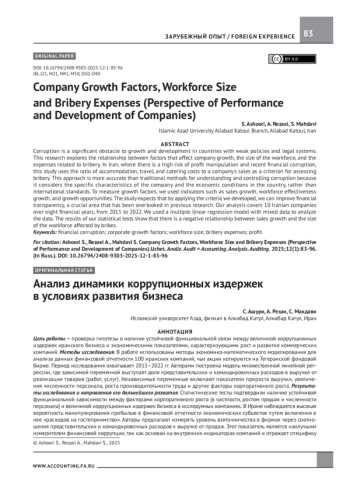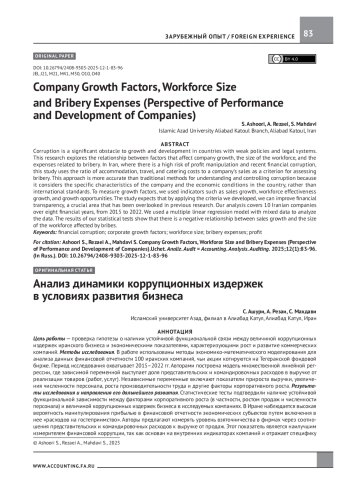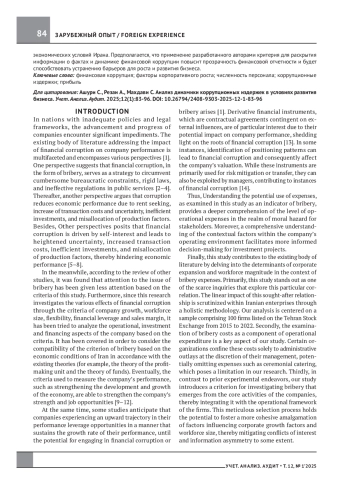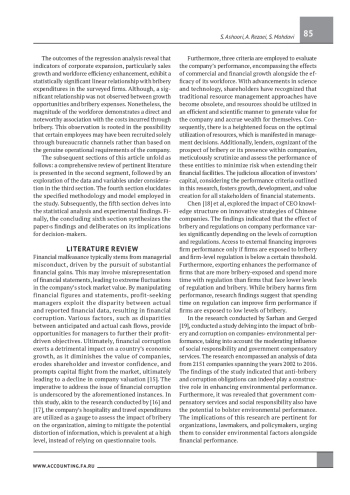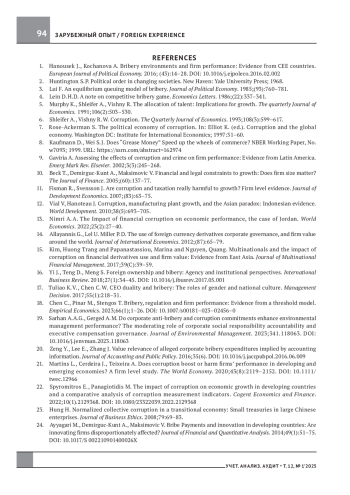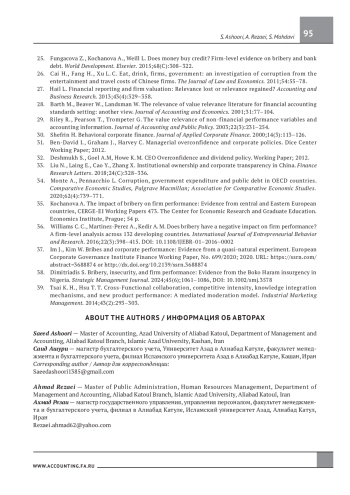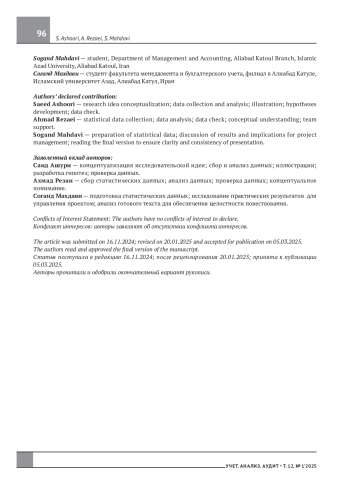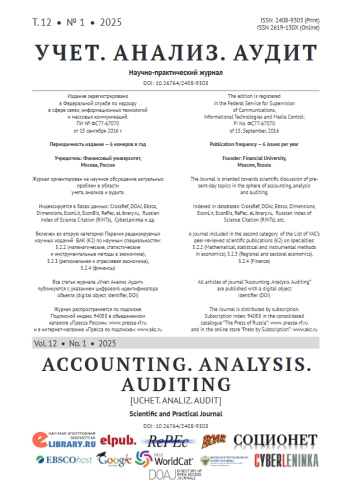Цель работы — проверка гипотезы о наличии устойчивой функциональной связи между величиной коррупционных издержек иранского бизнеса и экономическими показателями, характеризующими рост и развитие коммерческих компаний.
Методы исследования. В работе использованы методы экономико-математического моделирования для анализа данных финансовой отчетности 100 иранских компаний, чьи акции котируются на Тегеранской фондовой бирже. Период исследования охватывает 2015–2022 гг. Авторами построена модель множественной линейной регрессии, где зависимой переменной выступает доля представительских и командировочных расходов в выручке от реализации товаров (работ, услуг). Независимые переменные включают показатели прироста выручки, увеличения численности персонала, роста производительности труда и другие факторы корпоративного роста.
Результаты исследования и направления его дальнейшего развития. Статистические тесты подтвердили наличие устойчивой функциональной зависимости между факторами корпоративного роста (в частности, ростом продаж и численности персонала) и величиной коррупционных издержек бизнеса в исследуемых компаниях. В Иране наблюдается высокая вероятность манипулирования прибылью в финансовой отчетности экономических субъектов путем включения в нее «расходов на гостеприимство». Авторы предлагают измерять уровень взяточничества в фирмах через соотношения представительских и командировочных расходов к выручке от продаж. Этот показатель является наилучшим измерителем финансовой коррупции, так как основан на внутренних индикаторах компаний и отражает специфику экономических условий Ирана. Предполагается, что применение разработанного авторами критерия для раскрытия информации о фактах и динамике финансовой коррупции повысит прозрачность финансовой отчетности и будет способствовать устранению барьеров для роста и развития бизнеса.
Идентификаторы и классификаторы
- Префикс DOI
- 10.26794/2408-9303-2025-12-1-83-96
In order to address the issue of corruption and the use of travel and entertainment costs (ETC) divided by the company’s current year sales as a measure of bribery expenses, it is essential to clarify both the theoretical foundation and practical implications of this approach. The ratio serves as an indicator of corporate governance and financial integrity, as it encapsulates discretionary spending that may correlate with unethical business practices, such as bribery.
Список литературы
1. Hanousek J., Kochanova A. Bribery environments and firm performance: Evidence from CEE countries. European Journal of Political Economy. 2016; (43):14-28. https://doi.org/10.1016/j.ejpoleco.2016.02.002
2. Huntington S. P. Political order in changing societies. New Haven: Yale University Press; 1968.
3. Lui F. An equilibrium queuing model of bribery. Journal of Political Economy. 1985;(93):760-781.
4. Lein D. H.D. A note on competitive bribery game. Economics Letters. 1986;(22):337-341.
5. Murphy K., Shleifer A., Vishny R. The allocation of talent: Implications for growth. The quarterly Journal of Economics. 1991;106(2):503-530.
6. Shleifer A., Vishny R. W. Corruption. The Quarterly Journal of Economics. 1993;108(3):599-617.
7. Rose-Ackerman S. The political economy of corruption. In: Elliot K. (ed.). Corruption and the global economy. Washington DC: Institute for International Economics; 1997:31-60.
8. Kaufmann D., Wei S. J. Does “Grease Money” Speed up the wheels of commerce? NBER Working Paper, No. w7093; 1999. URL: https://ssrn.com/abstract=162974
9. Gaviria A. Assessing the effects of corruption and crime on firm performance: Evidence from Latin America. Emerg Mark Rev. Elsevier. 2002;3(3):245-268.
10. Beck T., Demirguc-Kunt A., Maksimovic V. Financial and legal constraints to growth: Does firm size matter? The Journal of Finance. 2005;(60):137-77.
11. Fisman R., Svensson J. Are corruption and taxation really harmful to growth? Firm level evidence. Journal of Development Economics. 2007;(83):63-75.
12. Vial V, Hanoteau J. Corruption, manufacturing plant growth, and the Asian paradox: Indonesian evidence. World Development. 2010;38(5):693-705.
13. Nimri A. A. The Impact of financial corruption on economic performance, the case of Jordan. World Economics. 2022;23(2):27-40.
14. Allayannis G., Lel U. Miller P.D. The use of foreign currency derivatives corporate governance, and firm value around the world. Journal of International Economics. 2012;(87):65-79.
15. Kim, Huong Trang and Papanastassiou, Marina and Nguyen, Quang. Multinationals and the impact of corruption on financial derivatives use and fi value: Evidence from East Asia. Journal of Multinational Financial Management. 2017;39(C):39-59.
16. Yi J., Teng D., Meng S. Foreign ownership and bibery: Agency and institutional perspectives. International Business Review. 2018;27(1):34-45. https://doi.org/10.1016/j.ibusrev.2017.05.001
17. Tuliao K. V., Chen C. W. CEO duality and bribery: The roles of gender and national culture. Management Decision. 2017;55(1):218-31.
18. Chen C., Pinar M., Stengos T. Bribery, regulation and firm performance: Evidence from a threshold model. Empirical Economics. 2023;66(1);1-26. https://doi.org/10.1007/s00181-023-02456-0
19. Sarhan A.A.G., Gerged A.M. Do corporate anti-bribery and corruption commitments enhance environmental management performance? The moderating role of corporate social responsibility accountability and executive compensation governance. Journal of Environmental Management. 2023;341.118063. https://doi.org/10.1016/j.jenvman.2023.118063
20. Zeng Y., Lee E., Zhang J. Value relevance of alleged corporate bribery expenditures implied by accounting information. Journal of Accounting and Public Policy. 2016;35(6). https://doi.org/10.1016/j.jaccpubpol.2016.06.009
21. Martins L., Cerdeira J., Teixeira A. Does corruption boost or harm fi performance in developing and emerging economies? A firm level study. The World Economy. 2020;43(8):2119-2152. https://doi.org/10.1111/twec.12966
22. Spyromitros E., Panagiotidis M. The impact of corruption on economic growth in developing countries and a comparative analysis of corruption measurement indicators. Cogent Economics and Finance. 2022;10(1).2129368. https://doi.org/10.1080/23322039.2022.2129368
23. Hung H. Normalized collective corruption in a transitional economy: Small treasuries in large Chinese enterprises. Journal of Business Ethics. 2008;79:69-83.
24. Ayyagari M., Demirguc-Kunt A., Maksimovic V. Bribe Payments and innovation in developing countries: Are innovating firms disproportionately affected? Journal of Financial and Quantitative Analysis. 2014;49(1):51-75. https://doi.org/10.1017/S 002210901400026X
25. Fungacova Z., Kochanova A., Weill L. Does money buy credit? Firm-level evidence on bribery and bank debt. World Development. Elsevier. 2015;68(C):308-322.
26. Cai H., Fang H., Xu L. C. Eat, drink, firms, government: an investigation of corruption from the entertainment and travel costs of Chinese firms. The Journal of Law and Economics. 2011;54:55-78.
27. Hail L. Financial reporting and firm valuation: Relevance lost or relevance regained? Accounting and Business Research. 2013;43(4):329-358.
28. Barth M., Beaver W., Landsman W. The relevance of value relevance literature for financial accounting standards setting: another view. Journal of Accounting and Economics. 2001;31:77-104.
29. Riley R., Pearson T., Trompeter G. The value relevance of non-financial performance variables and accounting information. Journal of Accounting and Public Policy. 2003;22(3):231-254.
30. Shefrin H. Behavioral corporate finance. Journal of Applied Corporate Finance. 2000;14(3):113-126.
31. Ben-David I., Graham J., Harvey C. Managerial overconfidence and corporate policies. Dice Center Working Paper; 2012.
32. Deshmukh S., Goel A.M, Howe K. M. CEO Overconfidence and dividend policy. Working Paper; 2012.
33. Liu N., Laing E., Cao Y., Zhang X. Institutional ownership and corporate transparency in China. Finance Research Letters. 2018;24(C):328-336.
34. Monte A., Pennacchio L. Corruption, government expenditure and public debt in OECD countries. Comparative Economic Studies, Palgrave Macmillan; Association for Comparative Economic Studies. 2020;62(4):739-771.
35. Kochanova A. The impact of bribery on firm performance: Evidence from central and Eastern European countries, CERGE-EI Working Papers 473. The Center for Economic Research and Graduate Education. Economics Institute, Prague; 54 p.
36. Williams C. C., Martinez-Perez A., Kedir A. M. Does bribery have a negative impact on firm performance? A firm-level analysis across 132 developing countries. International Journal of Entrepreneurial Behavior and Research. 2016;22(3):398-415. https://doi.org/10.1108/IJEBR-01-2016-0002
37. Im J., Kim W. Bribes and corporate performance: Evidence from a quasi-natural experiment. European Corporate Governance Institute Finance Working Paper, No. 699/2020; 2020. URL: https://ssrn.com/abstract=3688874 or https://doi.org/10.2139/ssrn.3688874
38. Dimitriadis S. Bribery, insecurity, and firm performance: Evidence from the Boko Haram insurgency in Nigeria. Strategic Management Journal. 2024;45(6);1061-1086, https://doi.org/10.1002/smj.3578
39. Tsai K. H., Hsu T. T. Cross-Functional collaboration, competitive intensity, knowledge integration mechanisms, and new product performance: A mediated moderation model. Industrial Marketing Management. 2014;43(2):293-303.
Выпуск
Другие статьи выпуска
В статье представлен краткий анализ деятельности научной школы кафедры бухгалтерского учета РГЭУ (РИНХ) за 2023–2024 гг. Рассматриваются основные направления научной работы, в том числе связанные с выполнением НИР по хоздоговорной тематике и публикационной активностью. Подготовлены монографии, опубликованы статьи в рецензируемых научных журналах и тезисы по проведенным научно-практическим конференциям. Значительный вклад в развитие научной школы вносит профессорско-преподавательский состав кафедры, участвующий в научных публикациях, имиджевых мероприятиях различного уровня и поддерживающий творческие связи с вузами Российской Федерации и организациями-партнерами университета. Научная школа и ее представители получили широкое признание на уровне ректората, государственных и общественных организаций.
Актуальность. В условиях перегруппировки логистических цепочек в экспорто-импортных операциях, ухода иностранных производителей с отечественного рынка из-за санкционного давления особенно актуальной становится оценка компаний на рынке.
Целью исследования является поиск методов и подходов для оценки стоимости компании и ее репутации в условиях структурной перестройки экономики в результате обострения международных отношений в аспекте спекулятивного и производственного подходов, взаимодействия традиционных финансовых показателей и добавленной стоимости. В статье рассмотрены методы оценки бизнеса в условиях рестрикций против российской экономики. Выделены спекулятивный и производственный подходы к оценке добавленной стоимости. Качественные характеристики стоимостно-ориентированного управления раскрыты в разрезе указанных подходов. Использованы методы мультипликатора валовой ренты, прямой капитализации и дисконтирования, а также рыночный подход методом «избыточных прибылей» для оценки репутационного капитала.
Результаты. Приведен пример расчета стоимости недвижимости в условиях санкционной нестабильности и достижения целей импортозамещения. На примере нематериальных активов, таких как гудвилл, бренд, раскрыты вопросы достоверности оценки репутационного капитала компании как результат высокого качества производства, инвестиционной привлекательности с учетом корпоративной социальной ответственности. Для этого выделены отличия между спекулятивным и производственным подходами в увеличении стоимости репутационного капитала. Предложены уточнения в парадигме стоимостно-ориентированного управления с опорой преимущественно на производственные достижения, а не спекулятивные манипуляции. Рассмотрена методика определения стоимости активов, деловой репутации и бренда в оценке репутационного капитала с авторскими уточнениями.
Выводы. Комплекс приведенных расчетов образует методику оценки активов и репутационного капитала, необходимых для открытия и инвестирования новых производств, экономического роста, основанного на высокой эффективности и технологичности, построения устойчивой и динамичной экономики, а также снижения доли импорта товаров и услуг в структуре валового внутреннего продукта в соответствии с Указом Президента РФ «О национальных целях развития Российской Федерации на период до 2030 года и на перспективу до 2036 года».
В статье представлен комплексный анализ процессов трансформации делового климата в России, основанный на исследовании механизмов взаимодействия государственных институтов и предпринимательского сообщества.
Цель исследования — анализ механизмов взаимодействия государства и бизнеса для улучшения делового климата в России.
Методы исследования включают статистический анализ, опросы предпринимателей, оценку инвестиционной активности и факторов, влияющих на развитие бизнеса. Особое внимание уделяется актуальной проблеме формирования эффективной системы обратной связи между органами власти и бизнесом как ключевого фактора успешной реализации стратегических преобразований в экономике страны. На основе обширного статистического материала и результатов опросов представителей бизнес-сообщества исследуются современные тенденции инвестиционной активности российских предприятий. Проведен детальный анализ факторов, существенно влияющих на деловой климат, включая оценку условий кредитования, доступности трудовых ресурсов и эффективности мер государственной поддержки. Выявлены и систематизированы основные барьеры, препятствующие развитию предпринимательской деятельности. Особое внимание уделено административным ограничениям, проблемам доступа к финансовым ресурсам и несовершенству нормативно-правового регулирования. В работе обоснована необходимость создания многоканальной системы коммуникации между государственными институтами и бизнесом, включающей как традиционные форматы взаимодействия, так и современные цифровые инструменты. Сделан акцент на вопросах обеспечения прозрачности процесса принятия управленческих решений и механизмах учета мнения предпринимательского сообщества. Практическая значимость исследования заключается в разработке конкретных рекомендаций по совершенствованию механизмов взаимодействия государства и бизнеса, направленных на создание благоприятных условий для развития предпринимательства, стимулирование инвестиционной активности и повышение конкурентоспособности российской экономики в современных условиях.
Актуальность темы изучения динамики среднедушевых доходов населения России обусловлена рядом факторов, в первую очередь, отставанием доходов от инфляции, а также асинхронностью ее колебаний относительно реальных доходов населения.
Цель данного исследования заключается в применении набора математико-статистических методов к базе данных, отражающих динамику среднедушевых доходов населения России. Визуализация исходной информации и результатов анализа, а также проведение расчетов осуществлялись в среде программирования R. Для достижения поставленной цели были использованы общенаучные методы, такие как анализ, синтез, сравнение и исторический метод, а также математико-статистические методы, включая графический и эконометрические методы.
Основные результаты работы можно представить следующим образом: динамика среднедушевых доходов демонстрирует общий тренд к росту на интервале с 2012 по 2023 г., при этом наблюдается корректировка динамики под влиянием кризисов; описание динамики среднедушевых доходов проводилось на основе трех конкурирующих моделей, наиболее успешными из которых оказались модель ARIMA и модель Хольта – Винтера; прогнозы, полученные на основе эконометрических моделей, показали дальнейший рост доходов с сохранением сезонной волны. Дальнейшая разработка темы среднедушевых доходов включает анализ дифференциации субъектов РФ по уровню среднедушевых доходов, а также выявление влияния факторов на вариацию доходов в регионах.
Преобразование массива разнородных отчетных данных, формируемых экономическими субъектами как в обязательном, так и добровольном порядке, в информационную экосистему цифровой корпоративной отчетности является важным шагом создания единой национальной структуры отчетности и способствует эффективному решению стратегических задач государства в рамках реализации национального проекта «Экономика данных» и других инициатив.
Цель исследования заключается в развитии концептуальных положений, теоретических и методологических подходов к формированию и раскрытию информации в системе цифровой корпоративной отчетности. В ходе работы использовались методы дедукции и индукции, логического и структурного анализа, эмпирического исследования, контент-анализа, сравнения и группировки.
Объектом исследования является корпоративная отчетность ведущих российских компаний, признанных лидерами в области раскрытия информации.
Предмет исследования — совокупность теоретических, методических и практических решений по обеспечению прозрачности компаний в системе корпоративной отчетности.
Научная новизна исследования состоит в определении границ и содержания корпоративной отчетности и разработке модели цифровой корпоративной отчетности, включающей: систему принципов-требований формирования и раскрытия отчетной информации; образ и стиль корпоративной отчетности; структурные элементы (состав и характеристики); источники и методы сбора и агрегации первичных данных; интеграционные решения по гармонизации и связанности финансовых и нефинансовых показателей; технологические решения формирования и представления отчетной информации; механизмы обеспечения прозрачности данных (инструментарий оценки достоверности отчетной информации). Данная работа является частью комплексного научного исследования.
Результаты исследования могут представлять интерес для национальных регуляторов, научного сообщества, профессиональных объединений и бизнес-сообществ.
Разнородный характер объектов отражения в интегрированном учете требует критического анализа уже задействованного и перспективного бухгалтерского методологического инструментария, способного отразить не только прошлые, но и перспективные хозяйственные операции и ситуации. Для целей целостного учетного отражения разнородных частей и элементов устойчивого развития в рамках отчетности об устойчивом развитии можно воспользоваться тремя методологическими подходами: 1) блочный подход формирования отдельных групп показателей с разными измерителями на основе соответствующих цифровых платформ; 2) расчет сводных показателей на основе методов шкалирования; 3) использование концепции совокупности капиталов, ориентированных на различные варианты бухгалтерской балансовой методологии. Наиболее перспективным направлением дальнейшего развития интегрированной отчетности следует признать использование совокупности капиталов, позволяющих в рамках статической балансовой теории наиболее полно оценивать не только текущий уровень устойчивости, но и ее перспективы, в том числе структурные составляющие и разнообразие обязательственных отношений не только финансового, но и эколого-социального и интеллектуального характера. Структурные составляющие в рамках концепции капитала должны быть ориентированы на Международные стандарты финансовой отчетности, особенно в части операционных сегментов и капитала, где предусмотрена возможность использования в системе учетных координат видов и сфер деятельности.
Целью исследования является сравнительный анализ эффективности использования различных концептуальных установок бухгалтерской науки применительно к целям устойчивого развития, а также рассмотрение применения иных подходов для формирования соответствующей группы показателей и критериев, относящихся к данной категории.
Результатом исследования является выявление и обоснование использования положений органической балансовой теории для оценки уровня устойчивого развития, а также необходимость существенных корректировочных действий натурально-стоимостного измерения устойчивости применительно к отечественной бухгалтерской теории и практике.
Статистика статьи
Статистика просмотров за 2025 год.
Издательство
- Издательство
- ФИНУНИВЕРСИТЕТ
- Регион
- Россия, Москва
- Почтовый адрес
- 125167, город Москва, Ленинградский пр-кт, д. 49/2
- Юр. адрес
- 125167, город Москва, Ленинградский пр-кт, д. 49/2
- ФИО
- Прокофьев Станислав Евгеньевич (Ректор)
- E-mail адрес
- rector@fa.ru
- Контактный телефон
- +8 (499) 9439580
